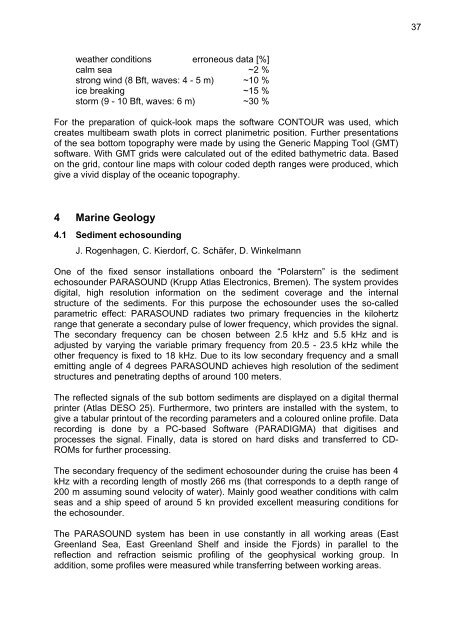the Expedition ARKTIS-XIX/4 of the research vessel POLARSTERN ...
the Expedition ARKTIS-XIX/4 of the research vessel POLARSTERN ...
the Expedition ARKTIS-XIX/4 of the research vessel POLARSTERN ...
Create successful ePaper yourself
Turn your PDF publications into a flip-book with our unique Google optimized e-Paper software.
wea<strong>the</strong>r conditions erroneous data [%]<br />
calm sea ~2 %<br />
strong wind (8 Bft, waves: 4 - 5 m) ~10 %<br />
ice breaking ~15 %<br />
storm (9 - 10 Bft, waves: 6 m) ~30 %<br />
For <strong>the</strong> preparation <strong>of</strong> quick-look maps <strong>the</strong> s<strong>of</strong>tware CONTOUR was used, which<br />
creates multibeam swath plots in correct planimetric position. Fur<strong>the</strong>r presentations<br />
<strong>of</strong> <strong>the</strong> sea bottom topography were made by using <strong>the</strong> Generic Mapping Tool (GMT)<br />
s<strong>of</strong>tware. With GMT grids were calculated out <strong>of</strong> <strong>the</strong> edited bathymetric data. Based<br />
on <strong>the</strong> grid, contour line maps with colour coded depth ranges were produced, which<br />
give a vivid display <strong>of</strong> <strong>the</strong> oceanic topography.<br />
4 Marine Geology<br />
4.1 Sediment echosounding<br />
J. Rogenhagen, C. Kierdorf, C. Schäfer, D. Winkelmann<br />
One <strong>of</strong> <strong>the</strong> fixed sensor installations onboard <strong>the</strong> “Polarstern” is <strong>the</strong> sediment<br />
echosounder PARASOUND (Krupp Atlas Electronics, Bremen). The system provides<br />
digital, high resolution information on <strong>the</strong> sediment coverage and <strong>the</strong> internal<br />
structure <strong>of</strong> <strong>the</strong> sediments. For this purpose <strong>the</strong> echosounder uses <strong>the</strong> so-called<br />
parametric effect: PARASOUND radiates two primary frequencies in <strong>the</strong> kilohertz<br />
range that generate a secondary pulse <strong>of</strong> lower frequency, which provides <strong>the</strong> signal.<br />
The secondary frequency can be chosen between 2.5 kHz and 5.5 kHz and is<br />
adjusted by varying <strong>the</strong> variable primary frequency from 20.5 - 23.5 kHz while <strong>the</strong><br />
o<strong>the</strong>r frequency is fixed to 18 kHz. Due to its low secondary frequency and a small<br />
emitting angle <strong>of</strong> 4 degrees PARASOUND achieves high resolution <strong>of</strong> <strong>the</strong> sediment<br />
structures and penetrating depths <strong>of</strong> around 100 meters.<br />
The reflected signals <strong>of</strong> <strong>the</strong> sub bottom sediments are displayed on a digital <strong>the</strong>rmal<br />
printer (Atlas DESO 25). Fur<strong>the</strong>rmore, two printers are installed with <strong>the</strong> system, to<br />
give a tabular printout <strong>of</strong> <strong>the</strong> recording parameters and a coloured online pr<strong>of</strong>ile. Data<br />
recording is done by a PC-based S<strong>of</strong>tware (PARADIGMA) that digitises and<br />
processes <strong>the</strong> signal. Finally, data is stored on hard disks and transferred to CD-<br />
ROMs for fur<strong>the</strong>r processing.<br />
The secondary frequency <strong>of</strong> <strong>the</strong> sediment echosounder during <strong>the</strong> cruise has been 4<br />
kHz with a recording length <strong>of</strong> mostly 266 ms (that corresponds to a depth range <strong>of</strong><br />
200 m assuming sound velocity <strong>of</strong> water). Mainly good wea<strong>the</strong>r conditions with calm<br />
seas and a ship speed <strong>of</strong> around 5 kn provided excellent measuring conditions for<br />
<strong>the</strong> echosounder.<br />
The PARASOUND system has been in use constantly in all working areas (East<br />
Greenland Sea, East Greenland Shelf and inside <strong>the</strong> Fjords) in parallel to <strong>the</strong><br />
reflection and refraction seismic pr<strong>of</strong>iling <strong>of</strong> <strong>the</strong> geophysical working group. In<br />
addition, some pr<strong>of</strong>iles were measured while transferring between working areas.<br />
37

















